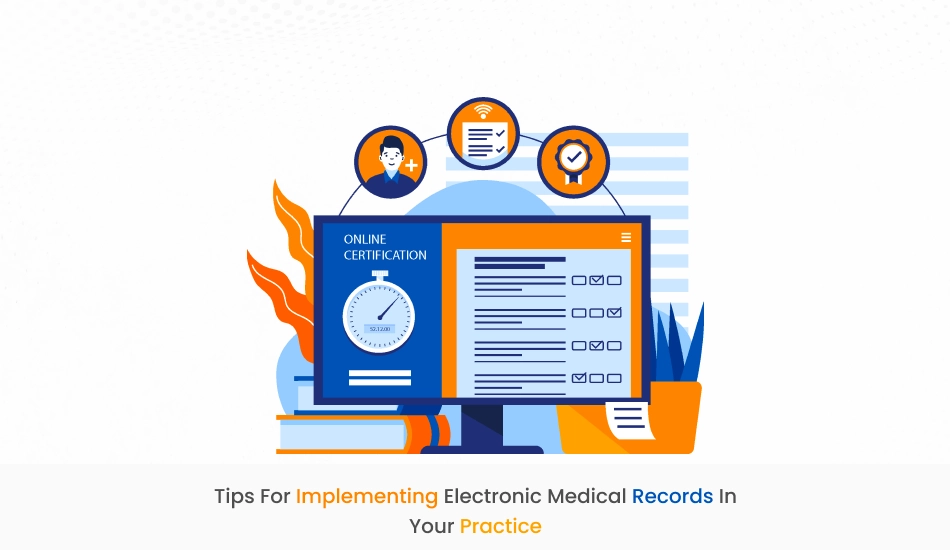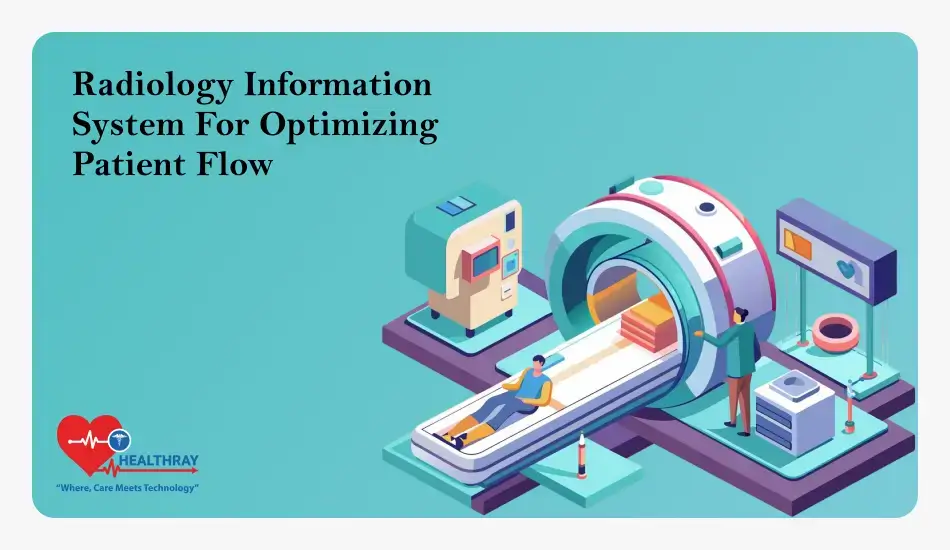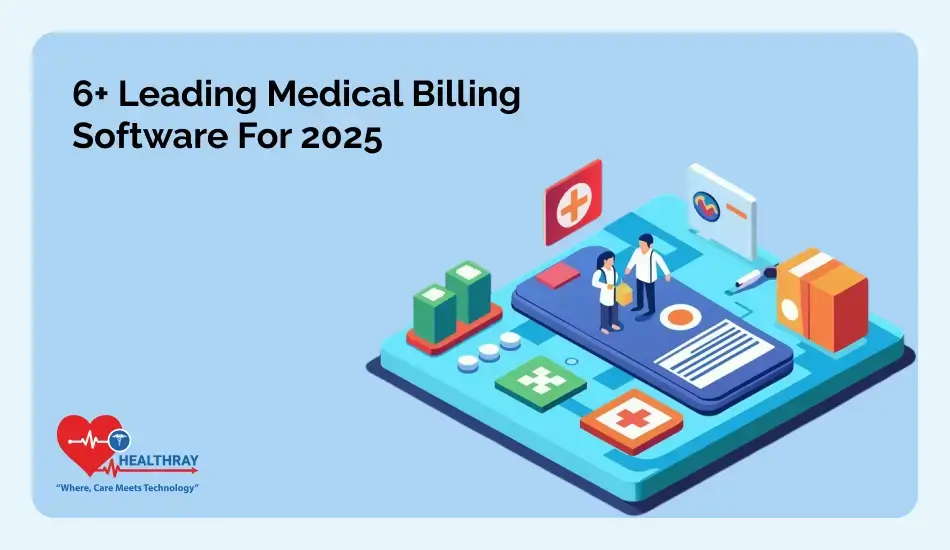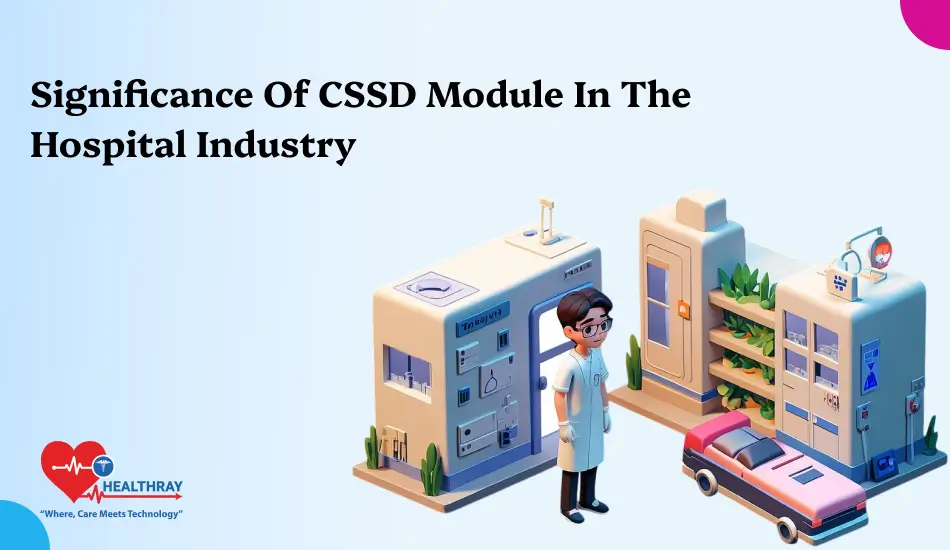Quick Summary
Electronic medical records (EMRs) must be realized with careful planning, continuing assistance, and preparation. The most significant benefits and the slightest disturbance in your practice address issues related to workflow, ensure information exactness and address the need for user input.
Introduction
Electronic medical records are one of the most crucial aspects of electronic health records that contribute to modern healthcare systems. This is because they contribute to streamlining the whole patient’s medical history and record of information and details.
EHRs make it conceivable for medical experts to access total, real-time patient information, which speeds up and improves the precision of diagnosis and treatment choices. Hence by utilizing digital records instead of paper, healthcare groups can better coordinate patient care, eliminate blunders, and increment patient safety.
The electronic health records technology comes up with the modern approach for handling healthcare services and improving data efficiency. Improving administrative workflow from managing appointments to analyzing real-time reports. Moreover, the EHR system software meets diverse patient requirements such as speedy claim management, book appointments instantly, medicine delivery to home, and speedy communication with providers.
Expanding EMR Software form effectiveness is crucial for enhancing patient privacy and security, healthcare conveyance, and system adequacy. When EHR forms are streamlined, healthcare workers can work more profitably and commit more time to patient care, liberating them from exploring complex form systems.This blog will elaborate on tips to help you implement Electronic Medical Records (EMR/EHR) Solutions in your physician practice.
What is EMR implementation?
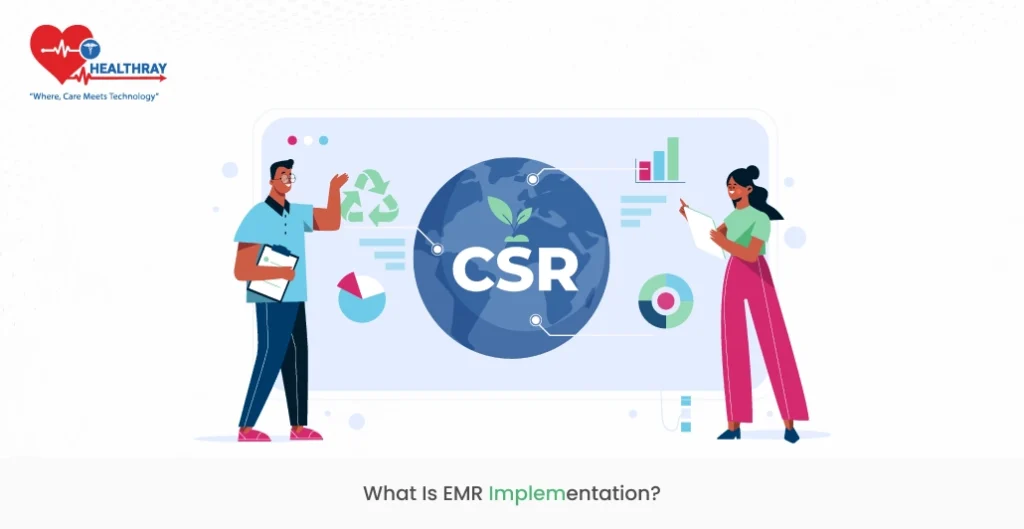
Electronic medical records are seen as a manner that can help simplify processes. Hence the processes are patient information, enhance productivity, and lessen the total cost associated with the medical record and information management. In addition to being advantageous, the use of EMR systems in healthcare facilities raises the standard of care. But you will have to consider certain factors while implementing electronic medical records, such as:
- human factors,
- ergonomics,
- workflows
- environmental conditions
All of these factors are necessary to enhance the quality of health care with lower costs. Moreover, it also helps with employee and patient safety. The process of incorporating medical record software into an organization’s workflow is known as electronic medical record implementation. Moreover the steps of this implementation include selecting and preparing the EMR systems. Later, it involves ensuring compliance with all privacy rules and regulations, training the care team, and troubleshooting the issues.
The electronic medical record system has interactive reports, all appointments in a single dashboard, provide prompt alerts regarding emergency scenarios, administer hospital income, and maintain exact records of medical expenses. Moreover, it improves patient records, quick exchange of clinical documents, and improves medical billing.
Additionally, it is superficial to support clinical research and maintain associated accounts. The electronic health records (EHR) maintains patient history, reduces patient visits, and minimizes medical errors. Furthermore, It facilitates ambulatory services, allows healthcare providers to attend the patient remotely and may conduct long discussions.
Generally, medical practitioners do not disclose their personal numbers due to their privacy or have a danger of being trapped in a medical crime. Moreover, they don’t have much time to communicate with their patients free of cost. With the clinical management software, physicians can earn money and connect with specialists in their free time.
Although many health care providers worry about the system’s cost factor, it is necessary to enhance patient care and medical practice efficiency. The time of implementation process of Electronic Medical Records System varies as per many factors, including:
- the system’s level of complexity
- the practice’s size
- the location of the server, i.e., cloud-based or on-site
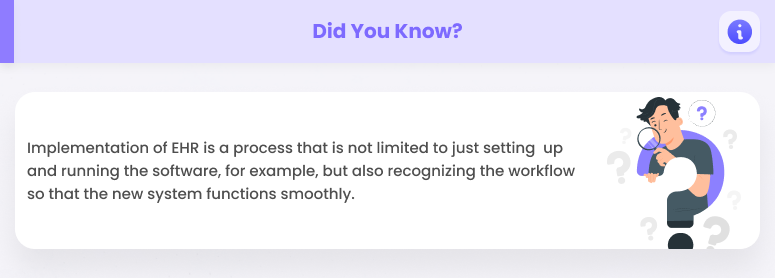
Key Statistics of electronic medical records
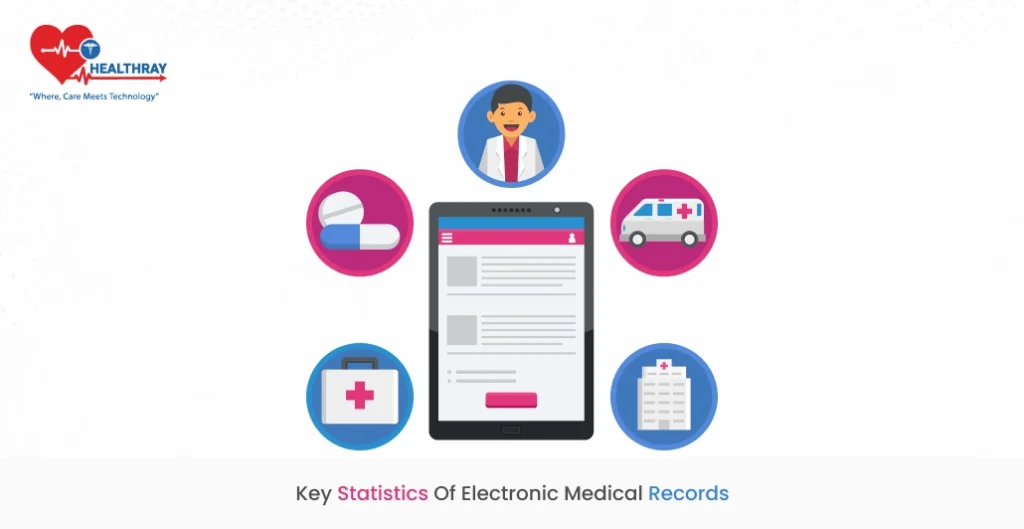
Large clinics that have integrated the EMR into their center operations are feeling the advantages. The optimized process across the hospital and healthcare value chain reduces or stops income leaks. Hence when EMR is utilized over time, costs will decrease since less cash will be spent on the organization, and data exactness will rise.
Thanks to the EMR’s simple and precise information accessibility, specialists can give patients improved care. Moreover proficiency in sharing medical records and the quality of information are improved when clinical information and medical records are collected at the point of care.
The data assembled is utilized by administrative bodies and pharmaceutical enterprises to upgrade the PMS (post-marketing surveillance) of medicines. Moreover superior treatment and larger reimbursements for prescription amounts are given to the patients. In conclusion, EMR employs innovation to improve process efficiency, diminish income leakage, and raise patient joy.
The showcase for electronic medical records in India was expected to be worth $514 million in 2022. It is projected to grow at a compound annual growth rate (CAGR) of 7% between 2022 and 2030, reaching $884 million.
Minor challenges can also obstruct the use of EMRs in the healthcare sector.The primary EHR problems are as follows:
- Cost of Use.
- Breakdown of the workflow
- privacy-related worries
- training that takes time
- technical resource limitations
- Insufficient interoperability
There are specific ways to overcome these challenges. This text will discuss tips for successfully implementing electronic medical records.ds.
Top tips to follow while employing EMRs
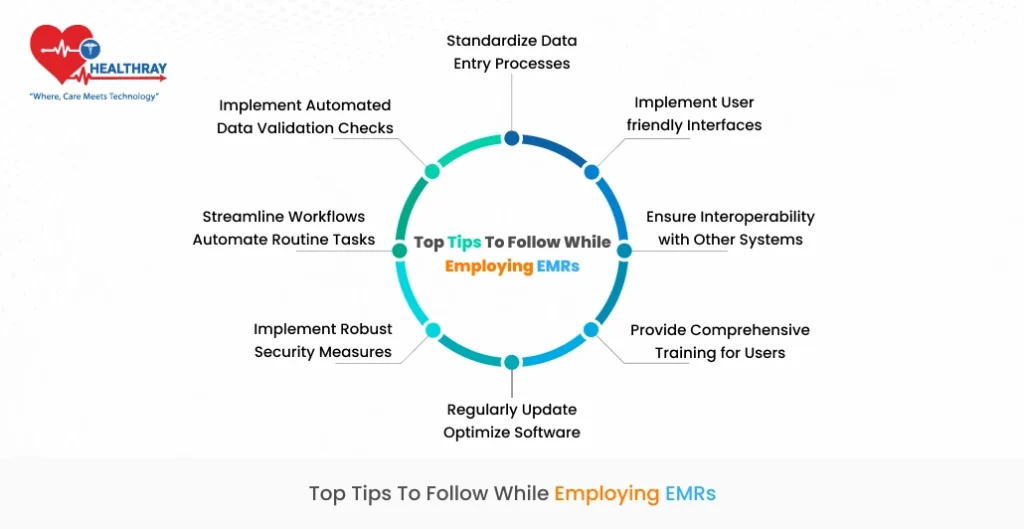
Standardize Data Entry Processes
Adequacy in the EHR information section depends on standardizing the strategies. It guarantees consistency, minimizes mistakes, and propels communication among healthcare systems. Moreover healthcare providers can progress patient care and results by streamlining operations, improving data accuracy, and ensuring consistency in information entry.
Strategies for standardizing the process of data entry are:
- Reliable Formats: Make indistinguishable data section formats to guarantee steady recording throughout all sections and help data input.
- Use Dropdown Menus: Incorporate dropdown choices to routinely use inputs to lessen mistakes and energize fruitful information determination.
- Automated Data Validation: Decrease blunders and improve by and expansive data quality by utilizing mechanized tests to affirm entered information.
- Clear Data Formatting Rules: Give explicit designing necessities to ensure consistency and understanding in information section procedures.
Regular Training Sessions: Organize visit staff preparing sessions to support dependable data input strategies and engage ongoing progression.
Implement User-friendly Interfaces
If you are looking for or increased proficiency, it is necessary to affirm that electronic health records have direct interfaces that are easy to use. Hence you should give all thanks to smart planning. Know that healthcare specialists report increased patient fulfillment, decreased errors, and streamlined workflows.
Intuitive interfaces decrease the training costs, reduce aggregate time on accomplish tasks, enhance precision in any healthcare activity, and enhance physician experience. It decreases confusion in the minds of front-desk employees, physicians, and patients. Therefore, the EHR software assists to minimize risks, reduces errors, increases customer retention, and amplifies productivity.
You must reorganize the interfaces, decrease wait times, simplify forms, and incorporate advanced patient welfare care. Hence it can optimize the clinic EHR system’s efficiency in giving healthcare.
Tips to execute user-friendly interfacing:
- Embrace Standard Conventions: You must utilize standard communication guidelines such as FHIR or HL7 to empower seamless data exchange between particular frameworks.
- Capabilities for Interfacing: One should confirm that the EHR system for your patient can communicate with other healthcare IT frameworks. It includes imaging and lab systems.
- Tools for Information Mapping: Alter the data groups and structures between different frameworks. You can do it by utilizing data mapping gadgets to lock in interoperability without client intervention.
- APIs for integration: Allow independent developers to access your EHR’s integration APIs. It is in order to advance interoperability and improve client pleasure.
- Regular Compatibility Testing: Schedule updates and testing to ensure expanding interoperability. Moreover, setting benchmarks and systems for healthcare development.
Ensure Interoperability with Other Systems
One must maintain EHR interoperability if you want to encourage information exchange simply between healthcare frameworks. Hence by this we can improve the coordination of a patient’s medical history, records, and other medical suppliers data.
This integration encourages exact and thorough information sharing. Hence it speeds up paperwork, decreases mistakes, and definitely improves healthcare results. For the advantage of patients, healthcare providers, and suppliers themselves. Moreover interoperability contributes to a coherent and engaging healthcare environment.
The best methods for guaranteeing EHR compatibility
- Adopt Standard Conventions: You must use standard communication standards such as FHIR or HL7. Hence it enables seamless information transfer between specific frameworks.
- Capabilities for Interfacing: Make sure you verify that the EMR System Software for your patient can communicate with other healthcare IT systems, including imaging and lab systems.
- Tools for Information Mapping: Change the information groups and structures between different systems using information mapping devices to lock in interoperability without client intervention.
- APIs for integration: Permit independent engineers to access your EHR’s integration APIs in order to promote interoperability and improve user pleasure.
- Regular Compatibility Testing: Schedule upgrades and testing to guarantee increasing interoperability while creating benchmarks and frameworks for healthcare innovation.
Provide Comprehensive Training for Users
One must maximize system utilization and EHR clients must encounter thorough training for it. Hence talented staff can utilize the system’s features effectively, decreasing mistakes and optimizing its capabilities. Through competent and ensured utilization of EHRs, this theory in instruction improves workflow capability and information quality and eventually leads to overwhelming patient care.
Strategies for giving EHR clients careful training:
- Onboarding Programs: Give organized onboarding sessions that cover the critical capabilities and functionalities of the EHR system to show modern users.
- Role-specific Planning: Customize training sessions, agreeing with clients’ needs to maximize their comprehension of the system and guarantee that it is noteworthy to their assignments.
- Interactive Workshops: Give practical errands in instinctive workshops so that clients can sharpen their capacities in a secure setting.
- Online Training Modules: Grant effectively accessible online preparation courses so clients can quickly consider EHRs and study the fabric again as required to ensure non stop learning.
- Feedback Framework: Give a framework for clients to convey criticism so that issues can be rapidly settled, considerations can be coordinated into future planning, and input can be gathered.
Regularly Update and Optimize Software
You must ensure security, satisfying state-of-the-art healthcare requests, and following data advancements and movements. Moreover all of these depend on EHR software that is always updated and improved.
You must know that upgrades improve client encounters and system survivability by presenting security upgrades, reports for bugs, repairs, and enhancements. Hence this proactive approach drives data judgment, framework dependability, and conformity to satisfying industry requirements.
On point tips to upgrade and optimize EHR frequently:
- Scheduled Updates: You must create certain guidelines for software redesigns. It is to make sure the EHR system is always up to date with security updates, new features, and enhancements.
- Performance Monitoring: One should keep monitoring client feedback and the EHR framework’s operation to identify opportunities. Hence it is for optimization and to make sure problems are not introduced by updates.
- User-driven Updates: You must serve the customer feedback, which is necessary for software updates. Also take into account their suggestions to advance usability, rationality, and user satisfaction.
- Security Patch Management: You must take prevention and timely application of security fixes to protect an EHR environment from potential vulnerabilities.
- Technology Integration: Stay known of advancements and industry best practices with every update to ensure that the EHR framework remains at the forefront of healthcare improvement.
Implement Robust Security Measures
Securing sensitive patient data in EHRs requires executing strong security measures. Frequent surveys, access limits, and advanced encryption reinforce data assurance. Vital components incorporate proactive chance checking, secure network conventions, and client verification.
Prioritizing physician cyber security ensures patient conviction and administrative compliance, decreases the likelihood of unauthorized access to data breaches, and shields the mystery and keenness of patients’ medical records.
Practical procedures for actualizing security measures:
- Access controls: To secure delicate data, you can execute strict access controls that permit as if they were authorized individuals to access it.
- Encryption protocols: Employ cutting-edge protocols for data while it’s in transit and at rest to ensure confidentiality and accuracy of records.
- Multi-factor authentication: Execute multiple-factor authentication for users so that they can include an additional layer of security to maintain a strategic distance from unauthorized access.
- Regular security reviews: Guarantee normal security reviews are necessary to distinguish vulnerabilities, improve potential dangers, and keep up compliance with information assurance rules.
- Employee training: Advise your staff about security best practices, show a security-conscious culture, security-conscious culture, and dispose of the chance of human-related mistakes.
Streamline Workflows and Automate Routine Tasks
Healthcare companies can increase their operational efficiency by automating repetitive processes and streamlining procedures. Healthcare workers can save a great deal of time, improve workflow, and lower the possibility of human error by implementing automation.
Through the integration of seamless workflows, EHR systems might optimize resource allocation, enhance data accuracy, and ultimately lead to better patient care. Hence, they help professionals focus on critical tasks.
Ways to enhance workflows and routine tasks;
- Workflow Investigation: Conduct a thorough examination of existing workflows to identify bottlenecks and zones for advancement in the EHR system.
- Task Automation: Execute computerization for scheduled assignments, such as arrangement updates and medicine refills, diminishing manual workload and upgrading effectiveness.
- Integration with Gadgets: Integrating EHR with sensors and medical devices will diminish manual entry, increase information precision, and mechanize information input.
- Adaptable Forms: Empower clients to modify workflows according to their interesting requirements and inclinations to maximize the EHR system’s personalized efficiency.
- Give real-time Updates and notices to caution medical experts of critical improvements and expedite reaction times and decision-making.
Implement Automated Data Validation Checks
When you streamline methods and repetitive tasks and automate reports in EHRs, healthcare settings see expanded operational productivity. Healthcare specialists and nurses use mechanization because it speeds up strategies, lowers manual mistake rates, and returns essential time.
EHR frameworks maximize asset utilization, increase information accuracy, and lead to more successful patient care by joining seamless forms. This liberates healthcare staff to concentrate on vital duties.
Strategies for streamlining regular chores and workflows:
- Workflow Examination: To discover any bottlenecks and areas where the EMR System framework needs improvement. Hence conduct a thorough investigation of the current workflows.
- Task Automation: Automate schedule methods like medicine refills and appointment reminders to decrease manual labor and increase efficiency.
- Integration with Gadgets: To decrease manual entry, increment data precision, automate information input, and coordinate EHR with sensors and medical gadgets.
- Customizable Workflows: Workflows that clients can customize to meet their particular necessities and inclinations will optimize the EHR system for individualized efficiency.
Real-time Updates: Alert medical experts of vital developments, assist response times and decision-making, and give real-time updates and notices.
How does Healthray help in implementing EMR systems into your practice?
Want to take your practice to the next level? Well, Healthray is here to help you out. With our AI-powered electronic medical records (EMR\EHR) solutions we can help ease burdens of your practice. Along with elevating the level of your practice, provide best-in-class patient care with our EMR solution. We as a top choice among all industry leaders know how to set an unmatchable standard for healthcare providers and our competitors. Hence our interesting features ultimately make us the top choice for people looking for EMR systems. We have security standards high of our EMR software that ensures confidentiality of patent data. Take your practice to new heights, leverage power of Healthray’s EMR software now!
Step towards digital era with our healthcare solution
Revamp your hospital facilities and embrace change for better healthcare management. Ease in managing and organizing large medical datasets leads to effective analysis. Seize the opportunity now!
Conclusion
In the long run, artificial intelligence will be useful in Electronic Health Record (EHR) systems to enable doctors with automatic information entry, custom-fitted treatment recommendations, and predictive analytics. Blockchain development will additionally help EHR systems to guarantee data and give patients more control over their medical records and treatments.
As all these enhancements happen, wearables and Internet of Things (IoT) gadgets will be necessary for continuous health data gathering and real-time electronic medical record checking. Hence it appears that as EHR innovation advances, practices and doctors must be more prepared to actualize it.
It would be basic to develop an imaginative culture and work in association with EHR suppliers and advantage providers. This will support them in their ongoing assessment of medical research and altar of workflows. It guarantees clinicians to make the best possible utilize of advanced EHR capabilities.
With its broad feature set and intuitive plan, Healthray’s Electronic Medical Records (EMR) is the best choice for healthcare pros. Moreover Healthray EMR improves practice operations though keeping up patient data security. It is much necessary for its strong security highlights, smooth interoperability, and configurable workflows.
Hence it is the best choice for modern healthcare practices looking to improve productivity and care quality due to its user-friendly support and seek support.
